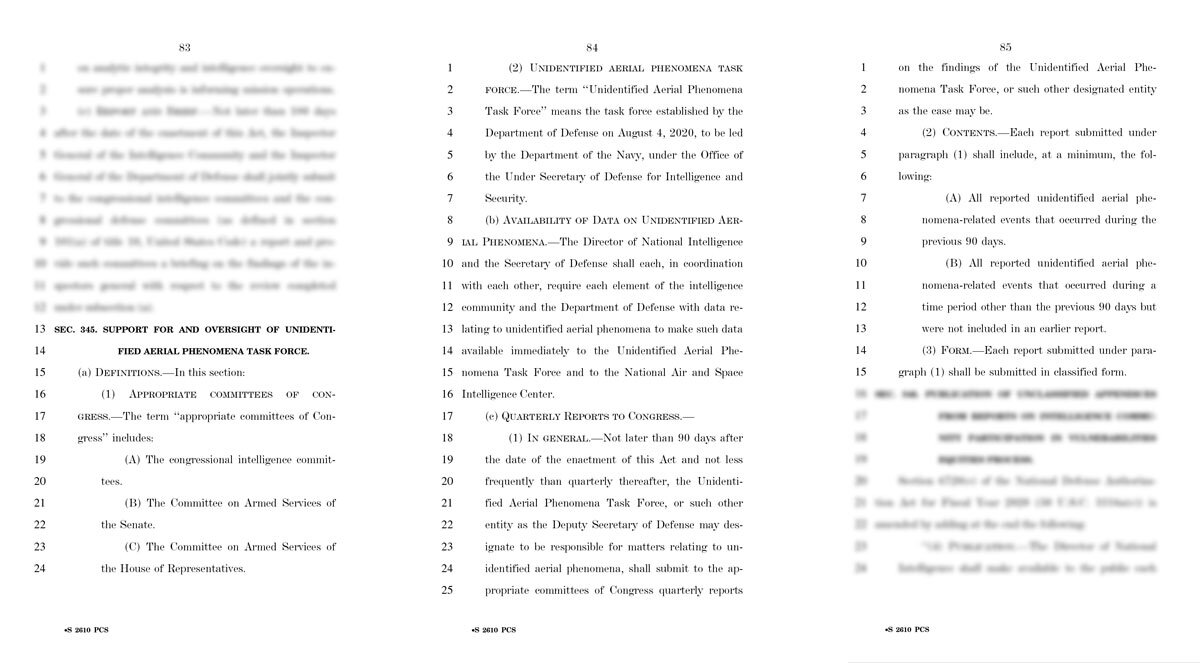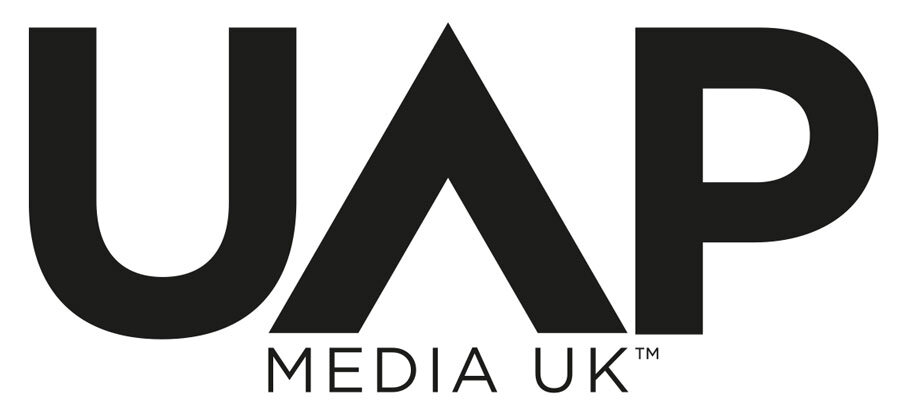UAP INFORMATION GATHERING NEWS: Intelligence Authorization Act for Fiscal Year 2022
IN LATE JULY 2021, the Senate Select Committee on Intelligence voted to pass S.2610, the catchily-titled Intelligence Authorization Act for Fiscal Year 2022. Before December 2020, such bills would have failed to catch the attention of those interested in Unidentified Aerial Phenomenon (UAP) as they contained dry summaries of future funding for more mundane intelligence gathering activities. With the creation of the Unidentified Aerial Phenomena Task Force (UAPTF) at the end of 2020, led by the Department of the Navy for the Office of the Under Secretary of Defense for Intelligence and Security (OUSD(I&S)), that perception changed. Pronouncements on intelligence matters are now closely scrutinised by those keeping a close watch on how America is dealing with the UAP issue. S.2610 was therefore no different. Looking at the small print buried away in the bill, it gave away some tantalising morsels of information, ones that did not appear to have been previously announced anywhere.
Clearly, the US Government, through the aforementioned Intelligence committee, takes the incursions by UAP into its military exercise areas and other sensitive locations very seriously. How it views the issue privately is another question altogether, but in public terms it has not ruled much out. The June 2021 Preliminary Assessment published by the UAP Task Force on behalf of the Office of the Director of National Intelligence could not confirm that US technology was to blame for sightings but left the door open for the possibility of either foreign adversaries or something else entirely being the cause. The Assessment also listed 144 UAP reports received from the US Navy and also stated that the US Air Force had recently established its own information collecting service. As the USAF has traditionally been seen as an organisation at the forefront of attempts to hinder disclosure regarding UAP and UFOs, this was a welcome move. Whilst the Assessment’s findings did not satisfy some onlookers, many saw the report as a positive step forward, especially after the Deputy Secretary of Defense immediately directed the OUSD(I&S) to plan the formalisation of the UAPTF’s mission. Another part of the Deputy Secretary of Defense’s response was that the UAPTF, or whichever agency assumed its mission, would have reports of UAP within a fortnight of their occurrence. However, dissenting voices among the UAP/UFO community still questioned whether anything would come of all this. Did S.2610 contain any information that would allay their fears?
The National Air and Space Intelligence Center
Lurking deep in Section 345 of the bill, titled Support for and Oversight of Unidentified Aerial Phenomena Task Force, the following was included under the title Availability of Data on Unidentified Aerial Phenomena:
“The Director of National Intelligence and the Secretary of Defense shall each, in coordination with each other, require each element of the intelligence community and the Department of Defense with data relating to unidentified aerial phenomena to make such data available immediately to the Unidentified Aerial Phenomena Task Force and to the National Air and Space Intelligence Center.”
The Deputy Secretary of Defense’s reply to the Preliminary Assessment had mentioned two weeks for a time limit in submissions of UAP reports to the Task Force (or its successor), but the language is now “immediately”. Does this signify an increase in reports, political pressure to get some kind of handle on the issue or an admission of a huge gap in intelligence gathering and a desire to plug that hole – or all three? Surely a fortnight does not equate to “immediately” in the military and intelligence world?

However, the inclusion of the National Air and Space Intelligence Center (NASIC) in the efforts to make sense of UAP reports took many by surprise. An operational wing within the USAF that deals with Intelligence, Surveillance and Reconnaissance, NASIC is based at Wright-Patterson AFB near Dayton, Ohio. “Wright-Pat” has of course been a famous location in UFO history since the late 1940s, having been the home of Projects Sign, Grudge and Blue Book, together with rumours of crashed alien craft being housed in secret hangars. Bringing things back to the present and provable, NASIC provides the Department of Defense (DOD) with analysis on foreign air and space threats and is the primary source for such information. NASIC has a team of experts in various fields connected with air, space and cyber operations, which should allow the creation of scientific and technical data to an engineering level on UAP. According to the organisation’s website, these experts deliver “unique collection, exploitation, and analytic capabilities not found elsewhere.” It should therefore be no surprise that NASIC has been asked to join the effort in determining what threat UAP pose.
Tucked away in NASIC’s “About Us” website page is an overview of its personnel and organisation. One of the constituent elements is the Geospatial and Signatures Intelligence Group (GSIG). It may be worth remembering the following sentences contained within the UAPTF’s Preliminary Assessment:
“The UAPTF holds a small amount of data that appear to show UAP demonstrating acceleration or a degree of signature management. Additional rigorous analysis are necessary by multiple teams or groups of technical experts to determine the nature and validity of these data.”
NASIC’s teams of relevant subject matter experts would certainly have made it an easy choice for the DOD when they decided on which agencies to elicit analytical assistance in response to the June 2021 UAPTF report. Signature management covers a variety of methods in which a vehicle or craft can hide, disguise or alter its “appearance” from the wide range of detection equipment operated by military and civilian organisations. Whether by accident or design, such “jamming” or “spoofing” appears to have been a factor in the Nimitz encounter of November 2004 and may well have been encountered beyond that time. Jamming and spoofing by terrestrial adversaries is viewed as a potentially hostile act and so the DOD will no doubt wish to ascertain whether UAP represent technological advances by other countries, platforms with the ability to evade or make their detection extremely difficult. A new commanding officer has just taken over GSIG so it is hoped he will wish to make a good impression by pulling out all the stops to provide as much useful data as possible for the new quarterly reports.
Quarterly Reports to Congress
The other main point of interest contained within S.2610 was that the UAPTF, “or such other entity as the Deputy Secretary of Defense may designate to be responsible for matters relating to unidentified aerial phenomena”, was required to submit quarterly reports on its findings to the appropriate committees of Congress, beginning not later than 90 days after the date of the enactment of the Act. These committees are further defined as the congressional intelligence committees, the Committee on Armed Services of the Senate, and the Committee on Armed Services of the House of Representatives. Of course, the enactment date for S.2610 is different than the date the Preliminary Assessment was published, so we will have to wait a little longer for news of any further developments – or will we? Unfortunately, tucked away at the end of this particular section of the bill was the following wording, relating to the requirement to submit details to these relevant committees:
“Each report submitted under paragraph (1) shall be submitted in classified form.”
Anyone thinking that there was going to be a regular “data-dump” every few months from the DOD is sadly mistaken. Given that the DOD is presumably still unsure as to whether UAP represent a threat from a foreign adversary, it is likely that the majority of actual cases, plus any findings that the UAPTF or NASIC present to Congress, will not be released publicly. S.2160 did however elaborate on what form the reports would take. In addition to “all reported unidentified aerial phenomena-related events that occurred during the previous 90 days”, other events that took place before that timeframe and which were not included in any previous report will also be listed. This should ensure comprehensive coverage of everything UAP-related that is picked up by the numerous agencies and organisations listed in the UAPTF Preliminary Report. It is not known whether this encompasses historical cases for where data useful to NASIC still exists, or if there is now going to be a sudden trawl through old UFO reports. Although not specifically addressed, this still appears unlikely, probably due to a lack of sensor data that could accompany evidence from surviving witnesses – but we could be surprised yet.
Conclusions
The inclusion of this information in S.2610 demonstrates that there is a strong desire within the US Government to act on the recommendations listed in the UAPTF Preliminary Assessment and also the response from the Deputy Secretary for Defense. Putting in place a rolling 90-day timeframe for the submission of UAP reports to Congress shows a commitment beyond anything publicly mentioned. Bringing the expertise of NASIC to bear on the issue is another plus, as the UAPTF was not geared up to analyse such data in any case. How much information is eventually obtained by NASIC from the likes of the USAF, National Security Agency and National Reconnaissance Office is, of course, open to debate. Whether this ever sees the light of day is another question, and one which is probably answered in the negative for some time to come. The fact that NASIC is an operational wing of the USAF also creates a talking point.
Some commentators maintain that as the USAF have a large role in the new UAP intelligence-gathering process, the factions within that organisation who have kept a lid on the truth about UFOs since the late 1940s will again be able to hide, obfuscate or stonewall attempts to keep elected politicians and the general public “in the loop” about the issue. Although the USAF eventually created a six-month long pilot programme in November 2020 to collect data in “the most likely areas”, that work has now finished, and it is unclear whether the scheme has been extended, rolled out more widely or quashed. From the wording in S.2160, the USAF should be forwarding its UAP data immediately to the UAPTF, so it would be interesting to learn whether or not this is occurring.
Of course, the bill focusses more on the possible threat posed by China and also the so-called “Havana Syndrome” attacks on US personnel in recent years. That UAP feature in such a document at all speaks to the increasing importance of the issue across intelligence organisations, the military, politics and the general public in the US and elsewhere. China has already stated that it is also looking into UAP, and one can bet that the Russians are doing the same, only much more covertly. At the very least, the possibilities of gaining knowledge of technological advancement will spur on each country’s efforts in trying to solve the UAP riddle. No-one will want to be left behind in this new race, even if they are not prepared to say as much in public.
The fact that the quarterly reports will be classified is disappointing but not surprising. At a very basic level, UAP incursions represent an intelligence failure with regard to the ongoing safety of US military personnel. Failures highlight potential weaknesses that can be exploited by adversaries, so hiding this information away behind a “classified” label is an inevitable move. Those in search of the truth about UAP may not be happy about this but accepting processes which are at least partially in the public realm is much better than what had passed for the status quo up until 2017. Pressure on our elected representatives needs to be maintained, however, if we are going to see any of the results from this latest initiative.

